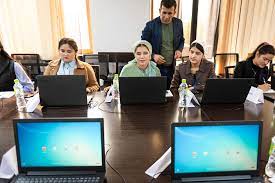Tools like the PDF editor empower students to learn, collaborate, and work with digitized educational resources. However, the growing digital divide has exposed inequality and associated problems with education.
Sadly, only a few students can access the internet or gadgets for learning. In this blog, we’ll highlight the causes of this technology gap and ways to create a level playing field for all students.
What is the digital divide in education?
The term digital divide describes the gap where access to technology is unequal across social, geographical, and economic backgrounds.
A small percentage of students use smartphones, computers, and other high-tech gadgets for their studies, while their peers don’t even have reliable internet access.
The digital divide in education is just like any other societal inequality crisis. As the gap widens, society will continue to produce an unhealthy mix of educated and less-educated people.
However, students should have equal access to educational resources, significantly digital learning aids. Therefore, schools must integrate technology to solve these educational issues across all levels.
There are several reasons that the digital divide is one of the current issues in education. Closing the gap created by technology for education begins with identifying how this inequality started.
What are the causes of digital divide in education?
Let’s identify the causes of this digital divide in the educational sector.
National development
Developed countries like the U.S. and the UK are more tech-inclined than places like India, Nepal, and Myanmar. In many parts of sub-Saharan Africa, where a steady power supply is still an uphill task, schools would need help employing digital teaching modes.
Moreover, these developing countries lack basic infrastructure such as telephone towers and WiFi cables in rural or suburban regions. Students in these areas will be limited to traditional classroom features while their counterparts in developed nations use new technologies.
Income
The average income in any country often determines its level of technology access. Among the list of current education issues is that many homes can barely afford quality education for their kids.
Wealthy families are buoyant enough to install computers, smart devices, and WiFi in their homes. In contrast, low-class families can barely afford the internet or relevant gadgets for their children, which could further widen the gap.
Education
Homes with graduates usually have increased access to technology, while uneducated families may struggle to adapt.
Moreso, students with educated parents can easily recognize the significance of the internet and gadgets for learning. By contrast, uneducated parents will require more convincing as regards why they should spend more money on digital tools.
7 Ways to Bridge the Digital Divide in Education
This digital divide has led to current educational issues such as a growing education gap, limited career opportunities, and technology segregation between people. To dissolve this chaos, we must mend the digital divide in education.
Here are some initiatives that can close this gap:
Provide technical support for teachers
One major problem in education technology is that teachers are not trained to use these tools. Schools must ensure teachers have the necessary hardware and software before implementing digital classroom strategies.
Beyond providing software, it’s crucial to focus on training and workshops on how teachers can integrate technology for instructional uses. When teachers are tech-savvy, transferring this knowledge to students becomes feasible.
Raise digital awareness
We need to adopt digital alternatives for doing things if we must narrow the divide. In raising awareness for the digital shift, tutors must seek quality tech solutions that place students at the forefront of development.
Running a digital classroom involves a lot of work, so students must comprehend the rules of digital interaction and collaboration. They must also recognize cultural differences and social standards that influence internet use.
Encourage digital literacy
Schools need to employ more learning strategies that turn students into digital literates. Beyond learning to use a computer, students must be adept at working with software and using tools for research and educational purposes.
Note that a computer literate isn’t necessarily digitally literate. To achieve digital literacy, students must possess relevant knowledge, skill, and attitude toward technology and smart devices.
Incorporate local language into content creation
When creating digital content for learners, it’s essential to factor in familiar language and learning concepts. Questions like, ‘How can digital tools or resources be relevant to students in rural communities?’ should be considered.
Learning resource creators should use more local languages in their course development. This way, students who are not fluent in English can benefit from studying in their native languages.
Create affordable digital resources
One common issue in education is the high cost of quality education. Tuition fees are getting so high that students are dropping out of school at an unprecedented rate. People who lament daily about the cost of tuition will find it more challenging to pay for digital learning resources.
School administrators must source affordable digital resources that students can access without breaking the bank. They can also collaborate with tech corporations and government organizations to provide digital technologies at subsidized rates.
Expand learning opportunities for special needs students
Closing the digital gap also involves making technology accessible for special-needs learning. Teachers should be equipped and encouraged to develop content and instructional materials for differently abled students.
Online learning resources should be available for people with difficulty in verbal communication, hearing disabilities, and learning disorders. Providing these tools will ultimately boost their engagement as well as their confidence with technology use.
Address social barriers
When bridging the digital divide, it’s vital to deal with the social issues that initiated the gap. For instance, there are 26% more male smartphone users than women in Asia. Promoting access to technology and support for women will eliminate the gender digital divide.
By all means, stakeholders must combat digital exclusion towards children in poor communities. Governments must also prioritize funding for modern technologies and digital infrastructure for children in developing regions.
Conclusion
Access to digital tools has improved remote learning and overall student performance in schools that adopted digital technologies. Nevertheless, the digital divide has created more issues in teaching and learning today.
Differences in education, race, and income levels mainly contribute to the digital divide. Solving this problem in education today requires the collaborative effort of policymakers, schools, teachers, students, and their parents.
Schools need to provide software and train teachers on how to use them. The selected technologies must be relevant, affordable, and accessible for all students involved.














